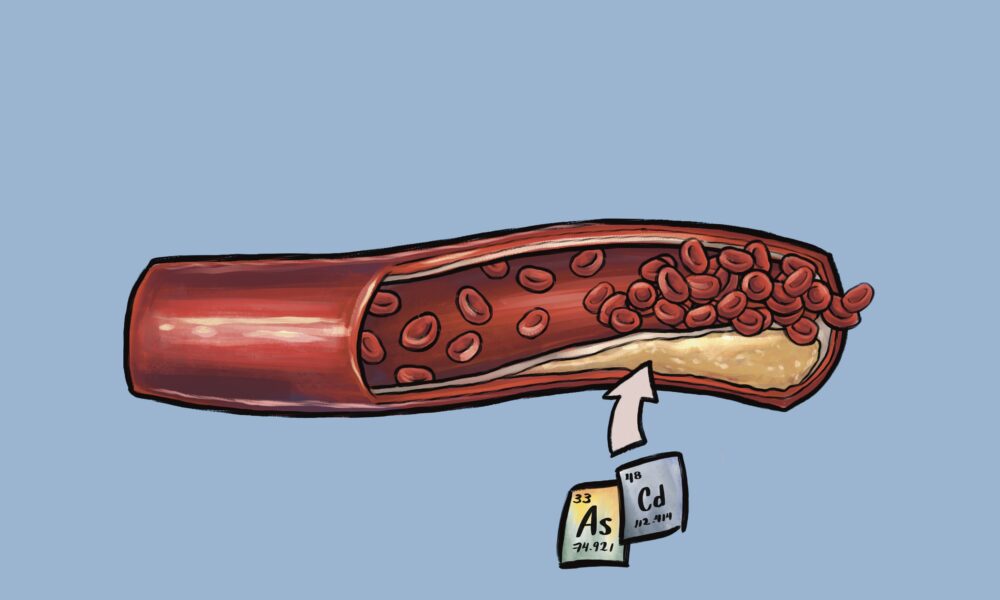Around the world, millions of people come in contact directly or indirectly with heavy metals, particularly cadmium and arsenic, thereby increasing their risk of heart disease.
Past studies have investigated the respective effects of these two metals on heart health at concentrations well beyond the levels that people are typically exposed to. However, these studies have not characterized their potential consequences when combined at low doses, which more closely mimics the complex real-world environment.
In a recently published paper, Nivetha Subramaniam, PhD candidate in the Faculty of Medicine and Health Sciences, and her team filled this research gap by investigating the effects of low-dose arsenic and cadmium on the development of a condition called atherosclerosis.
Atherosclerosis, the primary cause of heart disease, is characterized by the hardening of arteries due to the gradual buildup of plaque consisting of fats, cholesterol, and other substances inside the walls of arteries. For Subramaniam, arsenic represented the ideal candidate to further study atherosclerosis since the lab has historically worked with this element.
“We’ve already looked at the effect of moderate doses of arsenic, so in this study, we’d like to look at environmentally relevant concentrations,” Subramaniam said in an interview with The Tribune. “Apart from arsenic, we chose cadmium because cadmium has also been found to have pro-atherosclerotic effects.”
With atherosclerosis, plaque buildup causes the arteries to narrow, reducing blood flow to vital organs, such as the brain, kidneys, and heart. The constriction of coronary arteries, which supply blood to the heart, could lead to coronary artery disease, heart attack, or even heart failure. In addition to heavy metal exposure, risk factors for atherosclerosis include elevated blood pressure, abnormal cholesterol levels, smoking, obesity, physical inactivity, diabetes, and a high-fat diet.
Drinking water is one of the most common sources of heavy metal exposure. Other common sources include food, medicine, smoking, and certain occupations like mining and construction work.
The World Health Organization (WHO) recommends a safe threshold concentration of 10 parts per billion (ppb) for arsenic in drinking water and 3 ppb for cadmium. However, higher levels of heavy metals have been reported in numerous countries, including India and the United States.
In Subramaniam’s study, ApoE−/− mice—mice that share a relatively similar genetic profile with humans—were used to study the effect of heavy metal exposure on atherosclerosis development. This type of genetically modified mouse is currently the most widely used type in preclinical atherosclerosis studies.
“Mice have more good cholesterol than bad cholesterol, whereas humans have more bad cholesterol than good cholesterol. [That is to say that] if you were to provide mice with a high-fat diet every day, then they would still not develop atherosclerosis,” Subramaniam said. “So, we need to genetically manipulate the mice to obtain a genetic profile that is more similar to [that of] humans.”
The findings of the study suggest that arsenic, cadmium, and the combinations of both metals do not drastically promote atherosclerosis at low doses in males. On the contrary, low-dose arsenic significantly accelerates atherosclerosis in females.
Another notable finding is that low-dose mixtures of these two metals do not considerably promote atherosclerosis more than either metal individually.
While this is encouraging news, there is a caveat to this study: Mice metabolize arsenic considerably faster than humans, so it is likely that exposure to low-dose mixtures of arsenic and cadmium may produce more drastic effects on humans than on mice. One of Subramaniam’s goals for future research is to resolve this limitation.
“We will work with human cells to generate humanized mice where we insert the genes that metabolize arsenic in humans into mice, so this would allow us to better [generalize the study results] to humans,” Subramaniam said.
Subramaniam’s study is the first to explore the effects of exposure to low-dose metal mixtures on the progression of atherosclerosis. While this is innovative in itself, the paper also reinforces the need for more advanced technologies to produce genetically modified mice as well as complementary human studies.








